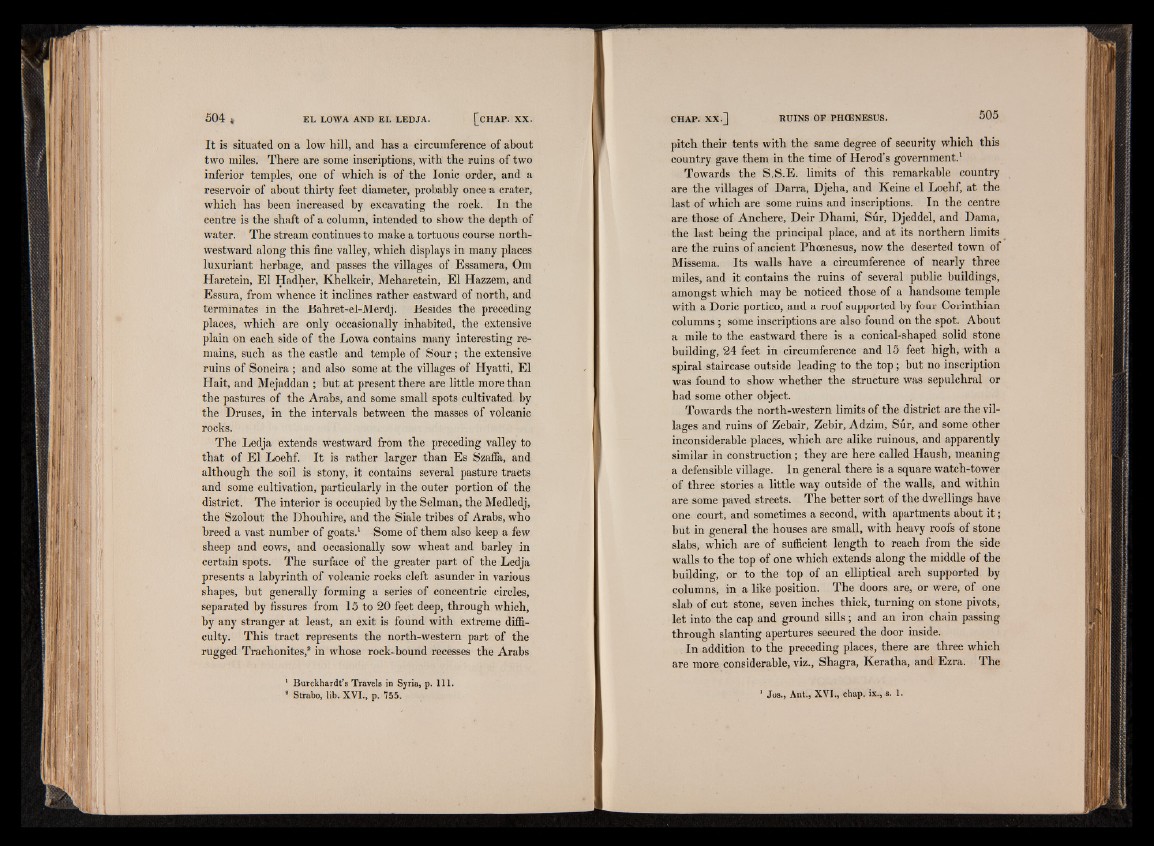
fCHAP. XX. L
It is situated on a low hill, and has a circumference of about
two miles. There are some inscriptions, with the ruins of two
inferior temples, one of which is of the Ionic order, and a
reservoir of about thirty feet diameter, probably once a crater,
which has been increased by excavating the rock. In the
centre is the shaft of a column, intended to show the depth of
water. The stream continues to make a tortuous course northwestward
along this fine valley, which displays in many places
luxuriant herbage, and passes the villages of Essamera, Om
Haretein, El Hadher, Khelkeir, Meharetein, El Hazzem, and
Essura, from whence it inclines rather eastward of north, and
terminates in the Bahret-el-Merdj. Besides the preceding
places, which are only occasionally inhabited, the extensive
plain on each side of the Lowa contains many interesting remains,
such as the castle and temple of Sour; the extensive
ruins of Soneira ; and also some at the villages of Hyatti, El
Hait, and Mejaddan ; but at present there are little more than
the pastures of the Arabs, and some small spots cultivated by
the Druses, in the intervals between the masses of volcanic
rocks.
The Ledja extends westward from the preceding valley to
that of El Loehf. It is rather larger than Es Szaffa, and
although the soil is stony, it contains several pasture tracts
and some cultivation, particularly in the outer portion of the
district. The interior is occupied by the Selman, the Medledj,
the Szolout the Dhouhire, and the Siale tribes of Arabs, who
breed a vast number of goats.1 -Some of them also keep a few
sheep and cows, and occasionally sow wheat and barley in
certain spots. The surface of the greater part of the Ledja
presents a labyrinth of volcanic rocks cleft asunder in various
shapes, but generally forming a series of concentric circles,
separated by fissures from 15 to 20 feet deep, through which,
by any stranger at least, an exit is found with extreme difficulty.
This tract represents the north-western part of the
rugged Trachonites,2 in whose rock-bound recesses the Arabs
1 Burckhardt’s Travels in Syria, p. 111.
s Strabo, lib. XVI., p. 755.
pitch their tents with the same degree of security which this
country gave them in the time of Herod’s government.1
Towards the S.S.E. limits of this remarkable country
are the villages of Darra, Djeha, and Keine el Loehf, at the
last of which are some ruins and inscriptions. In the centre
are those of Anchere, Deir Dhami, Sur, Djeddel, and Dama,
the last being the principal place, and at its northern limits
are the ruins of ancient Phoenesus, now the deserted town of
Missema. Its walls have a circumference of nearly three
miles, and it contains the ruins of several public buildings,
amongst which may be noticed those of a handsome temple
with a Doric portico, and a roof supported by four Corinthian
columns; some inscriptions are also found on the spot. About
a mile to the eastward there is a conical-shaped solid stone
building, 24 feet in circumference and 15 feet high, with a
spiral staircase outside leading to the top; but no inscription
was found to show whether the structure was sepulchral or
had some other object.
Towards the north-western limits of the district are the villages
and ruins of Zebair, Zebir, Adzim, Sur, and some other
inconsiderable places, which are alike ruinous, and apparently
similar in construction; they are here called Haush, meaning
a defensible village. In general there is a square watch-tower
of three stories a little way outside of the walls, and within
are some paved streets. The better sort of the dwellings have
one court, and sometimes a second, with apartments about i t ;
but in general the houses are small, with heavy roofs of stone
slabs, which are of sufficient length to reach from the side
walls to the top of one which extends along the middle of the
building, or to the top of an elliptical arch supported by
columns, in a like position. The doors are, or were, of one
slab of cut stone, seven inches thick, turning on stone pivots,
let into the cap and ground sills; and an iron chain passing
through slanting apertures secured the door inside.
In addition to the preceding places, there are three which
are more considerable, viz., Shagra, Keratha, and Ezra. The
1 Jos., Ant., XVI,, chap. ix., s. 1.